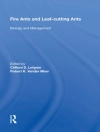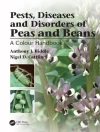This book provides a comprehensive overview of cutting-edge biotechnological approaches for enhancing plant secondary metabolites to address abiotic stress, offering valuable insights into the future of utilizing plants for medicinal and industrial purposes.
Various books on plant secondary metabolites are available, however, no book has an overview of the recent trends and future prospects of all the methods available to enhance the contents of the plant secondary metabolites. Plant Secondary Metabolites and Abiotic Stress aims to give an overview of all the available strategies to ameliorate abiotic stress in plants by modulating secondary metabolites using biotechnological approaches including plant tissue cultures, synthetic metabolic pathway engineering, targeted gene silencing, and editing using RNAi and CRISPR CAS9 technologies.
Cuprins
Foreword xxi
Preface xxiii
Acknowledgment xxv
About the Book xxvii
1 Biochemical Responses of Plants to Individual and Combined Abiotic Stresses 1
Kanchan Sharma, Kritika Jalota, Chiti Agarwal, Puja Pal and Suruchi Jindal
1.1 Introduction 2
1.2 Biochemical Responses to Individual Abiotic Stresses 3
1.3 Biochemical Responses to Combined Abiotic Stresses 16
1.4 Conclusion 26
References 27
2 Unraveling the Dynamics of Antioxidant Defense in Plants Under Drought Conditions 35
Gaurav Kumar
2.1 Introduction 36
2.2 Oxidative Stress in Plants Under Drought Condition 36
2.3 Antioxidant Defense System of Plants 43
2.4 Enzymatic Antioxidants and Their Response Against High ROS Under Drought Stress 43
2.5 ROS-Scavenging Non-Enzymatic Antioxidants and Their Response Under Drought Stress 55
2.6 Interplay of ROS With Reactive Carbonyl, Nitrogen, and Sulfur in Plant Cells: A Crosstalk Saga 62
2.7 Conclusion 64
References 65
3 Plant Metabolism and Abiotic Stress in Crops 81
Tuba Taziun, Bilal Ahmad Mir, Ritu Kumari, Nahid Akhtar and Atif Khurshid Wani
3.1 Introduction 82
3.2 Concepts and Types of Abiotic Stress in Crop Plants 83
3.3 Plant Metabolism 89
3.4 Conclusion 95
References 96
4 Targeting Compatible Solutes for Abiotic Stress Tolerance in Plants 105
Heena Shoket
4.1 Introduction 106
4.2 Stress Caused by Abiotic Factors 107
4.3 Present Compatible Solutes for Stress Tolerance in Plants 110
4.4 Genetic Engineering Perspective for Compatible Solutes Mediated Abiotic Stress Resistance in Plants 113
4.5 Importance of Ethylene in the Controlling of Osmolytes Under Abiotic Stress 117
4.6 Importance of Salicylic Acid in Controlling of Osmolytes Under Abiotic Stress 119
4.7 Importance of Cytokinin in the Controlling of Osmolytes Under Abiotic Stress 121
4.8 Importance of Abscisic Acid in the Controlling of Osmolytes in an Abiotic Environment 122
4.9 Conclusion 124
Author Contributions 124
Conflict of Interest 124
References 125
5 Oxalate Crystals and Abiotic Stress Tolerance in Plants 131
Puja Gupta, Ahtisham, Deepak Nandi, Sonu Ram Rohit Chhabra and Yudhishther Singh Bagal
5.1 Introduction 132
5.2 Formation of Crystals of Calcium Oxalate 135
5.3 Forms of Oxalate Crystals in Plants 137
5.4 Role of Oxalate Crystals to Cope with Abiotic Stresses 139
5.5 Conclusion 143
Acknowledgments 143
Competing Interests 143
References 143
6 Role of Signaling Molecules in Enhancing Abiotic Stress Tolerance in Plants 149
Reena S. Meshram
6.1 Introduction 150
6.2 Signaling Molecules 150
6.3 ROS Signaling 151
6.4 ABA in Stress Tolerance 152
6.5 Mitogen-Activated Protein Kinase (MAPK) 155
6.6 Cross-Talk Between Plants MAPK During Abiotic Stress Signal Transduction 155
6.7 CRISPR-Cas9 in Stress Tolerance 159
6.8 Conclusion 161
References 161
7 Impact of Abiotic Stress Signals on Secondary Metabolites in Plants 173
Darshana Patil and Avinash Patil
7.1 Introduction 174
7.2 Abiotic Stresses in Plants 175
7.3 Conclusion 184
7.4 Future Prospective 184
References 184
8 Role of Reactive Oxygen Species (ROS) in Plant Responses to Abiotic Stress 195
Mahesh V. Kawale, Rupali P. Shirsat, Pratiksha Salunke and Dipak K. Koche
8.1 Introduction 196
8.2 Role of ROS in Plant Growth and Development 197
8.3 Involvement of ROS in Plants’ Stress Response 199
8.4 ROS Regulation in Plants 200
8.5 Genes and Proteins Involved in ROS Regulation in Plants 201
8.6 Conclusion 202
References 206
9 Reactive Oxygen, Nitrogen, and Sulfur Species Under Abiotic Stress in Plants 213
Bilal Ahmad Mir, Tuba Taziun, Mushtaq Rasool Mir, Tahir ul Gani Mir, Ritu Kumari, Atif Khurshid Wani and Nahid Akhtar
9.1 Introduction 214
9.2 Abiotic Stress in Plants: Molecular Perspective 215
9.3 Role of Oxygen in Abiotic Stress 220
9.4 Role of Sulfur in Abiotic Stress 223
9.5 Role of Nitrogen in Abiotic Stress 224
9.6 Cross-Talk Between Oxygen, Sulfur, and Nitrogen During Abiotic Stress 229
9.7 Conclusion and Future Prospective 230
References 232
10 Regulation of Plant Hormones Under Abiotic Stress Conditions in Plants 243
Prashant Kumar, Sumel Ashique, Nitish Kumar, Anjali Jain, Himanshu Sharma, Surya Nath Pandey and Anita Singh
10.1 Introduction 244
10.2 ABA’s Function in Plant Defense Mechanisms 246
10.3 Hormonal Cross-Talk in Plant Defense 249
10.4 Plant Morphology and Anatomy 257
10.5 Photosynthesis 257
10.6 Hormonal Balance 258
10.7 Plants Under Abiotic Stress Benefit from Phytohormones Mediated by PGPR 259
10.8 Changes in Phytohormone Activity Caused by PGPR Under Drought 262
10.9 Future Prospects 265
10.10 Conclusion 265
Acknowledgments 266
References 266
11 Altering Secondary Metabolite Profiles in Barley for Crop Enhancement: Role of Novel ACT Domain Proteins 277
Hamida Banoo, Nelofer Husain and Shashi Kant Singh
11.1 Introduction 278
11.2 Methods 282
11.3 Results 284
11.4 Discussion 292
11.5 Conclusion and Future Research Directions 294
References 294
12 Metabolites and Their Regulation During Salinity Stress in Plants 299
Marykutty Sebastian, Kavya Bakka and Dinakar Challabathula
12.1 Introduction 300
12.2 Salt Stress Affects Plant Growth 301
12.3 Chloride Ion Toxicity 302
12.4 Na + Toxicity 304
12.5 Salinity Stress–Induced Oxidative Stress 306
12.6 Plant Responses Through Signaling and Metabolite Production 307
12.7 Metabolites and Their Regulation 309
12.8 Sugars and Sugar Alcohols 310
12.9 Secondary Metabolites 326
12.10 Nitrogen-Containing Metabolites 327
12.11 Other Metabolites 329
12.12 Metabolic Responses of Halophytes and Glycophytes During Salinity 330
12.13 How Plants Adapt to Salt Stress? A Comparative Approach 332
12.14 Conclusions and Future Perspectives 333
Acknowledgments 334
References 334
13 Phenolic Compounds in Plants 349
Ab Waheed Wani, Harjinder Kaur, Pallvi Verma, Sanjeev Kumar, Kondle Ravi, Anis Ahmad Mirza, Adil Rahim, Irfan Gani, Zarina and Saurabha Bhimrao Zimare
13.1 Introduction 350
13.2 Phenolic Acids 351
13.3 Flavonoids 355
13.4 Stilbenoids 366
13.5 Lignans 368
13.6 Conclusions and Further Research 371
References 372
14 Modulation of Metabolic Pathways Under Abiotic Stress in Plants 389
Piyush Vatsha, Md Reyaz Alam, Ladli Kishore, Padma Charan Behera and Abhay Kumar Mishra
14.1 Introduction 390
14.2 Agriculture’s Vulnerability to Abiotic Stressors 391
14.3 Adaptations of Plants Under Abiotic Stress 391
14.4 Chemical Signaling in Plants Under Abiotic Stress 393
14.5 Gene Modification in the Acetic Acid Pathway 404
14.6 Tolerability to Abiotic Stress Caused by Salicylic Acid 406
14.7 Modifying the Metabolism of Thiamine 407
14.8 Abiotic Oxidative Stress Tolerance is Modulated by Hydrogen Peroxide Priming: Implications From ROS Scavenging and Detoxification 408
14.9 Stress and Innate Immunity in the Synthesis of Secondary Metabolites in Plants 411
14.10 Conclusion 417
References 418
15 Specific Secondary Metabolites of Medicinal Plants and Their Role in Stress Adaptation 425
Oksana Sytar and Shokoofeh Hajihashemi
Abbreviations 426
15.1 Introduction 426
15.2 Use of Selected Plants as Potential Immunostimulants 427
15.3 Plants and Plant-Derived Compounds With Immunomodulatory Potential 429
15.4 Plant Secondary Metabolite: Description and Their Health Effects 447
15.5 Plant Secondary Metabolites: Adaptative Potential 451
15.6 Conclusion 452
References 453
16 Effect of Abiotic Stress on Terpene Biosynthesis in Plants 481
Dwaipayan Sinha, Rameesha Abid, Wrick Chakraborty, Maliha Rashid, Laxmi Kumari Gupta, Bushra Khan, Paramita Nandy Datta, Sabahat Noor, Pomila, Shakira Ghazanfar, Upala Saha, Ratul Bhattacharya and Sanchita Seal
16.1 Introduction 482
16.2 Terpenes: An Introduction and Classification 485
16.3 Biosynthesis of Terpenes 496
16.4 Functions and Mechanisms of Terpenes During Abiotic Stress 504
16.5 Conclusion 509
References 510
17 Exogenous Application of Plant Metabolites to Enhance Abiotic Stress Tolerance in Plants 525
Tahoora Batool Zargar, Oqba Basal and Szilvia Veres
17.1 Introduction 526
17.2 Plant’s Responses to Abiotic Stress 527
17.3 Exogenous Application of Plant Metabolites 532
17.4 Glutathione (GSH) 532
17.5 Melatonin (MEL) 533
17.6 Ascorbic Acid (As A) 539
17.7 Nitric Oxide (NO) 540
17.8 Auxin 541
17.9 24-Eppibrassinolide (EBL) 542
17.10 Proline 543
17.11 Market Development and Cost Analysis of Plant Metabolites 545
17.12 Future Prospects 546
17.13 Conclusion 547
Acknowledgments 548
References 548
18 Genetic Engineering of Secondary Metabolic Pathways in Crops for Improving Abiotic Stress 559
Suryakant Ranjan, Sana Bhat, Atif Khurshid Wani and Nahid Akhtar
18.1 Introduction 560
18.2 Role of Secondary Metabolites in Plants 561
18.3 Abiotic Stress and Secondary Metabolites 561
18.4 Genetic Engineering for Secondary Metabolite Production 567
18.5 Genome Editing Techniques for Generating Abiotic Stress–Tolerant Crops by Targeting SM Biosynthesis 576
18.6 Conclusion 578
References 579
19 Nanoelicitors Mediated Abiotic Stresses in Plant Defense Response Mechanisms: Current Review and Future Perspectives 591
Somkuwar Subhash R., Jayant H. Meshram, D. P. Gogle, R. G. Chaudhary, R. H. Mahakhode, Vishal N. Patil, Rahul B. Kamble, R. C. Sawant, J. V. Gadpayale and Rupali R. Chaudhary
19.1 Introduction 592
19.2 Major Classes of Secondary Metabolites 594
19.3 Nanomaterial as Elicitor 595
19.4 The Use of NPs to Protect Plants From Abiotic Stress 596
19.5 Nanoparticle Uptake, Translocation, and Internalization Pathways in Plants 598
19.6 How Nanoelicitors Respond to Abiotic Stressors? 599
19.7 The Way That NPs Signal Under Abiotic Stress Circumstances 602
19.8 Conclusion and Future Perspectives 604
References 610
20 Light Signaling and Plant Secondary Metabolites 623
Ganesh M. Nawkar, Tushar Khare, Vinay Kumar and Rahul Mahadev Shelake
20.1 Introduction 624
20.2 Photoregulation of PSMs 625
20.3 Role of Plant Secondary Metabolites in Regulating High Light Stress 629
20.4 Enhancing the PSM Production by Modulating the Light Environment 630
20.5 Conclusion 633
Acknowledgments 634
References 634
About the Editors 645
Index 651
Despre autor
Ganesh C. Nikalje, Ph D, an assistant professor of botany at Seva Sadan’s R. K. Talreja College of Arts, Science, and Commerce, University of Mumbai. During his doctoral work, he unraveled the salt tolerance mechanism of the facultative halophyte, Sesuvium portulacastrum, at both the molecular and metabolomic levels. In addition, he revealed additive and combined salt tolerance mechanisms in contrasting soybean genotypes. He has two independent research projects funded by the University of Mumbai and to date has 19 research papers, four books, 18 book chapters, and a research paper in a journal to his credit.
Mohd. Shahnawaz, Ph D, is an assistant professor in the Department of Botany, University of Ladakh, Kargil Campus, India. He has several years of teaching and postdoctoral research experience, working in diverse fields of life sciences including tissue culture of medicinal plants, genetic diversity assessment of medicinal plants using high-resolution molecular marks, enhancement of plants’ secondary metabolites contents, and biodegradation of plastic. He has published more than 20 research articles, nine book chapters, and 12 books of international repute.
Jyoti Parihar, Ph D, is an associate professor and Head of the Department of Pedagogy in Biosciences, Government Post Graduate College of Education, Jammu, India. She has more than 24 years of teaching experience at the undergraduate level and has presented her work at various national and international conferences. She has published more than ten research papers in journals of repute and has three book chapters and two edited books to her credit. Her main areas of expertise include plant reproductive biology and the medicinal plant, Artemisia maritime L.
Hilal Ahmad Qazi, Ph D, is an assistant professor in the Department of Botany, Government Degree College Pampore, Pulwama Jammu and Kashmir, India. He has more than 5 years of teaching experience at the undergraduate level and three years of postdoctoral teaching. He has worked on the effect of cold stress on proteome and metabolome of Digitalis purpurea in an independent project funded by the Indian Department of Science and Technology. He has presented his work at various national and international conferences and has published more than 20 research articles in peer-reviewed journals of repute, as well as several book chapters in books of international repute.
Vishal N. Patil, Ph D, is an assistant professor of botany at Vidyabharti College Rashtrasanth Tukadoji Maharaj Nagpur University, Nagpur, India, as well as a post-graduate teacher and recognized Ph D supervisor at the School of Science & Technology at Nagpur University. To date, he has published 25 research papers in various international journals, as well as five books and three book chapters by national and international publishers. He has been invited as a resource for different conferences and symposia, guest lecturer at different institutes, and has organized various national conferences.
Daochen Zhu, Ph D, is a professor at the Biofuel Institute, School of Environment and Safety Engineering, Jiangsu University, Zhenjiang, China. He is an editor and editorial board member of various peer-reviewed journals of international repute. His research group focuses on microorganism resource and diversity, enzyme-mediated valorization of lignin into commodity products, and biodegradation of organic pollutants. He is also interested in the plant secondary metabolites and mitigation of microplastic using bioremediation technology. He has over 50 peer-reviewed publications, 12 patents, four book chapters, and three edited books to his credit.












